Detailed Analysis of Taxation Law: Inheritance and Capital Gains
VerifiedAdded on 2023/01/05
|9
|2477
|92
Report
AI Summary
This report provides a detailed analysis of taxation law, addressing key aspects of inheritance tax (IHT) and capital gains tax (CGT). The report examines scenarios involving gifts, sales of assets, and the implications for IHT, including potentially exempt transfers (PETs) and chargeable lifetime transfers (CLTs). It explores the importance of differentiating between these types of transfers and their impact on tax liabilities. The report also discusses the availability and application of the nil rate band for IHT, and how it can be utilized. Furthermore, the report analyzes business asset disposal relief (BADR), including its conditions, benefits, and how it applies to capital gains on the sale of business assets. The analysis includes specific examples and calculations to illustrate the tax implications of various transactions. The report also covers the tax treatment of share transactions and the computation of capital gains, including the application of BADR. Overall, the report offers a comprehensive overview of these key areas of taxation law, providing valuable insights into tax planning and compliance.
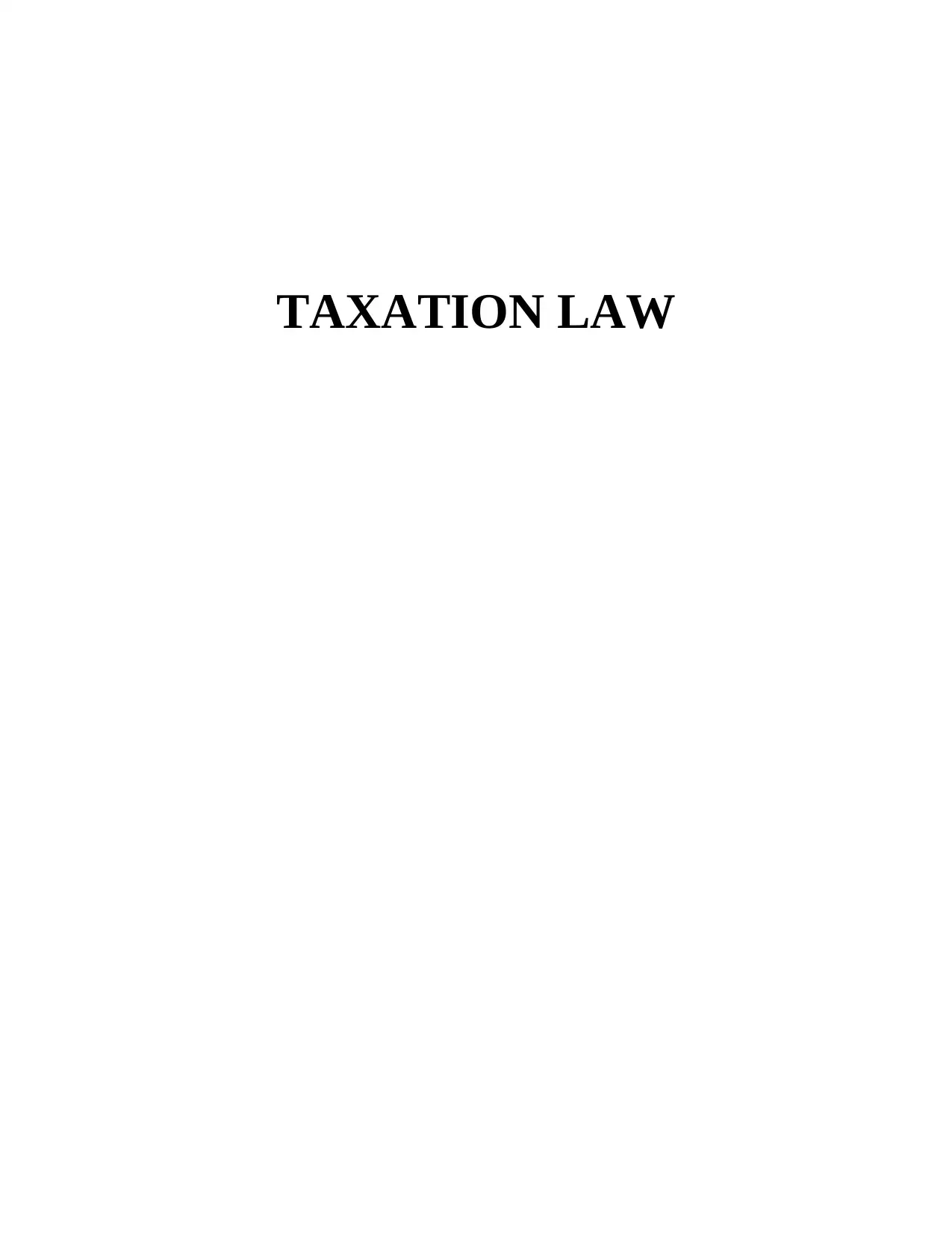
TAXATION LAW
Secure Best Marks with AI Grader
Need help grading? Try our AI Grader for instant feedback on your assignments.
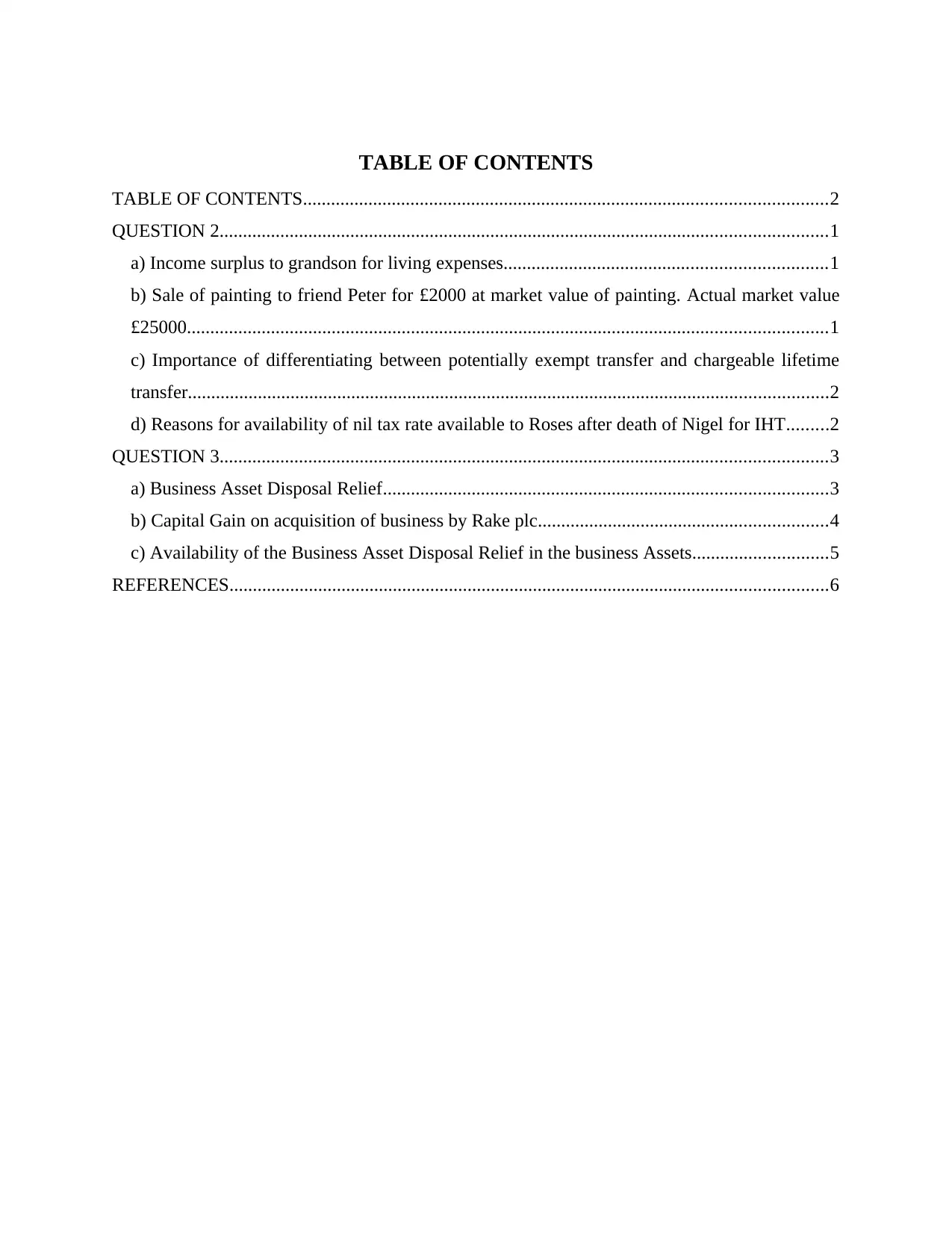
TABLE OF CONTENTS
TABLE OF CONTENTS................................................................................................................2
QUESTION 2..................................................................................................................................1
a) Income surplus to grandson for living expenses.....................................................................1
b) Sale of painting to friend Peter for £2000 at market value of painting. Actual market value
£25000.........................................................................................................................................1
c) Importance of differentiating between potentially exempt transfer and chargeable lifetime
transfer.........................................................................................................................................2
d) Reasons for availability of nil tax rate available to Roses after death of Nigel for IHT.........2
QUESTION 3..................................................................................................................................3
a) Business Asset Disposal Relief...............................................................................................3
b) Capital Gain on acquisition of business by Rake plc..............................................................4
c) Availability of the Business Asset Disposal Relief in the business Assets.............................5
REFERENCES................................................................................................................................6
TABLE OF CONTENTS................................................................................................................2
QUESTION 2..................................................................................................................................1
a) Income surplus to grandson for living expenses.....................................................................1
b) Sale of painting to friend Peter for £2000 at market value of painting. Actual market value
£25000.........................................................................................................................................1
c) Importance of differentiating between potentially exempt transfer and chargeable lifetime
transfer.........................................................................................................................................2
d) Reasons for availability of nil tax rate available to Roses after death of Nigel for IHT.........2
QUESTION 3..................................................................................................................................3
a) Business Asset Disposal Relief...............................................................................................3
b) Capital Gain on acquisition of business by Rake plc..............................................................4
c) Availability of the Business Asset Disposal Relief in the business Assets.............................5
REFERENCES................................................................................................................................6
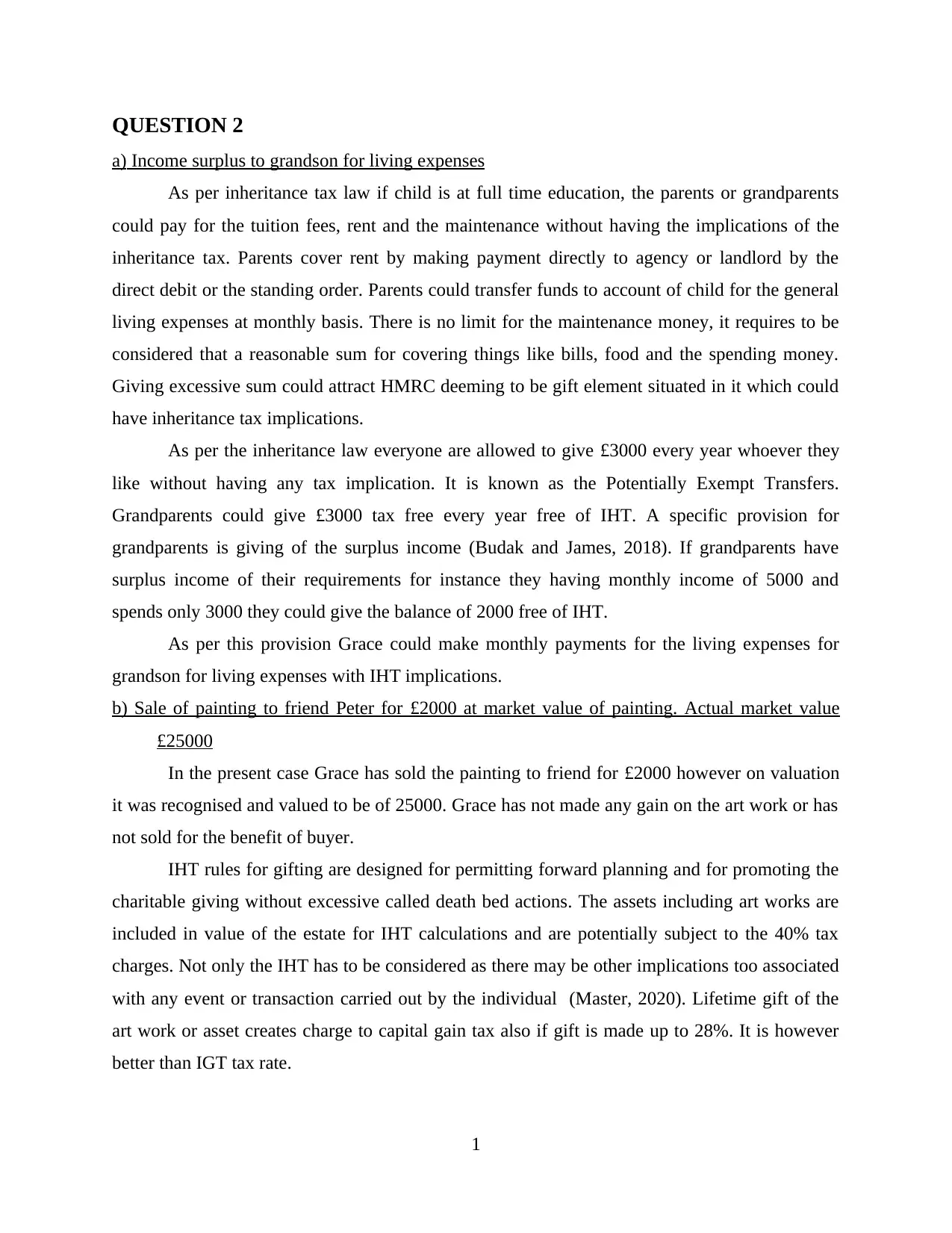
QUESTION 2
a) Income surplus to grandson for living expenses
As per inheritance tax law if child is at full time education, the parents or grandparents
could pay for the tuition fees, rent and the maintenance without having the implications of the
inheritance tax. Parents cover rent by making payment directly to agency or landlord by the
direct debit or the standing order. Parents could transfer funds to account of child for the general
living expenses at monthly basis. There is no limit for the maintenance money, it requires to be
considered that a reasonable sum for covering things like bills, food and the spending money.
Giving excessive sum could attract HMRC deeming to be gift element situated in it which could
have inheritance tax implications.
As per the inheritance law everyone are allowed to give £3000 every year whoever they
like without having any tax implication. It is known as the Potentially Exempt Transfers.
Grandparents could give £3000 tax free every year free of IHT. A specific provision for
grandparents is giving of the surplus income (Budak and James, 2018). If grandparents have
surplus income of their requirements for instance they having monthly income of 5000 and
spends only 3000 they could give the balance of 2000 free of IHT.
As per this provision Grace could make monthly payments for the living expenses for
grandson for living expenses with IHT implications.
b) Sale of painting to friend Peter for £2000 at market value of painting. Actual market value
£25000
In the present case Grace has sold the painting to friend for £2000 however on valuation
it was recognised and valued to be of 25000. Grace has not made any gain on the art work or has
not sold for the benefit of buyer.
IHT rules for gifting are designed for permitting forward planning and for promoting the
charitable giving without excessive called death bed actions. The assets including art works are
included in value of the estate for IHT calculations and are potentially subject to the 40% tax
charges. Not only the IHT has to be considered as there may be other implications too associated
with any event or transaction carried out by the individual (Master, 2020). Lifetime gift of the
art work or asset creates charge to capital gain tax also if gift is made up to 28%. It is however
better than IGT tax rate.
1
a) Income surplus to grandson for living expenses
As per inheritance tax law if child is at full time education, the parents or grandparents
could pay for the tuition fees, rent and the maintenance without having the implications of the
inheritance tax. Parents cover rent by making payment directly to agency or landlord by the
direct debit or the standing order. Parents could transfer funds to account of child for the general
living expenses at monthly basis. There is no limit for the maintenance money, it requires to be
considered that a reasonable sum for covering things like bills, food and the spending money.
Giving excessive sum could attract HMRC deeming to be gift element situated in it which could
have inheritance tax implications.
As per the inheritance law everyone are allowed to give £3000 every year whoever they
like without having any tax implication. It is known as the Potentially Exempt Transfers.
Grandparents could give £3000 tax free every year free of IHT. A specific provision for
grandparents is giving of the surplus income (Budak and James, 2018). If grandparents have
surplus income of their requirements for instance they having monthly income of 5000 and
spends only 3000 they could give the balance of 2000 free of IHT.
As per this provision Grace could make monthly payments for the living expenses for
grandson for living expenses with IHT implications.
b) Sale of painting to friend Peter for £2000 at market value of painting. Actual market value
£25000
In the present case Grace has sold the painting to friend for £2000 however on valuation
it was recognised and valued to be of 25000. Grace has not made any gain on the art work or has
not sold for the benefit of buyer.
IHT rules for gifting are designed for permitting forward planning and for promoting the
charitable giving without excessive called death bed actions. The assets including art works are
included in value of the estate for IHT calculations and are potentially subject to the 40% tax
charges. Not only the IHT has to be considered as there may be other implications too associated
with any event or transaction carried out by the individual (Master, 2020). Lifetime gift of the
art work or asset creates charge to capital gain tax also if gift is made up to 28%. It is however
better than IGT tax rate.
1
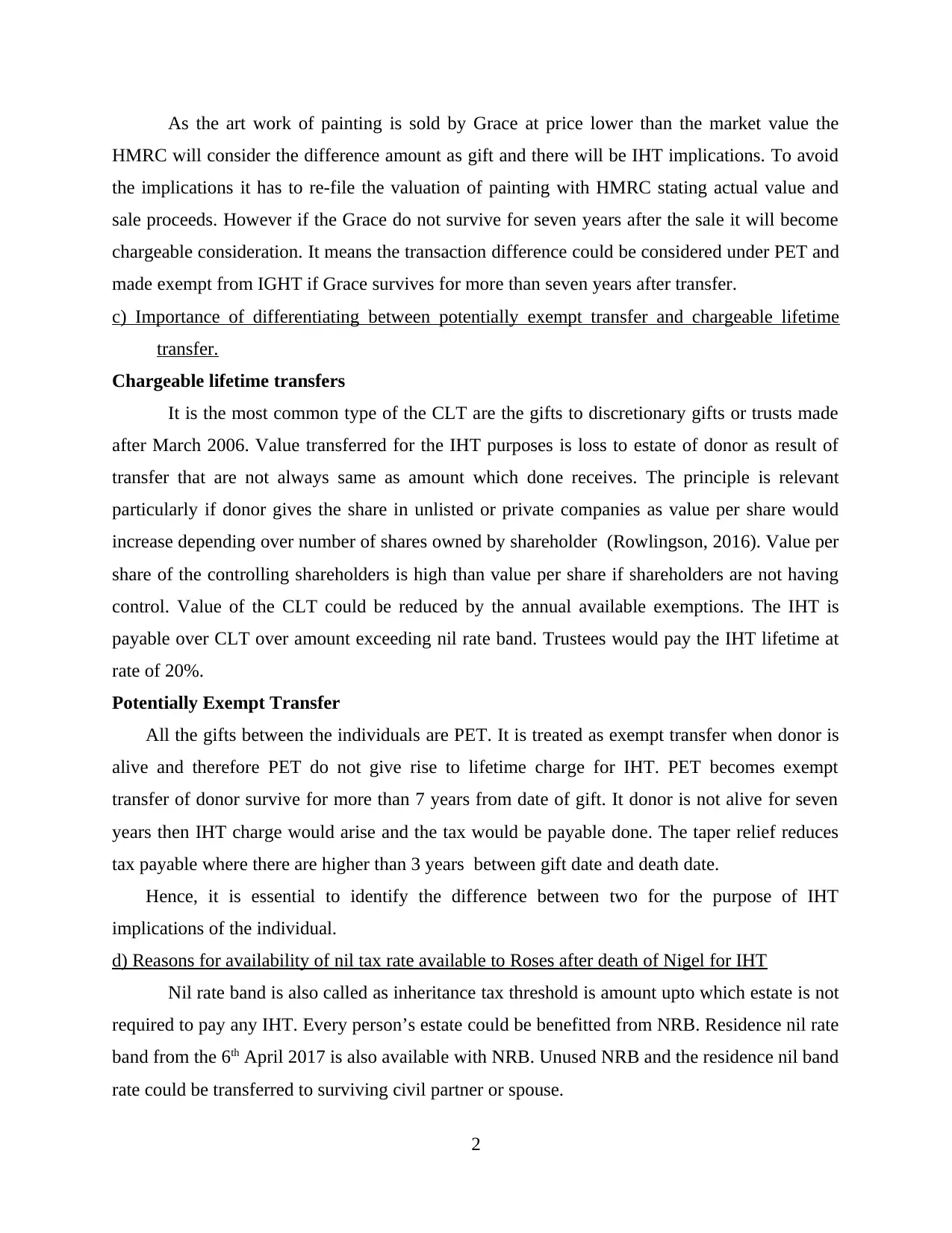
As the art work of painting is sold by Grace at price lower than the market value the
HMRC will consider the difference amount as gift and there will be IHT implications. To avoid
the implications it has to re-file the valuation of painting with HMRC stating actual value and
sale proceeds. However if the Grace do not survive for seven years after the sale it will become
chargeable consideration. It means the transaction difference could be considered under PET and
made exempt from IGHT if Grace survives for more than seven years after transfer.
c) Importance of differentiating between potentially exempt transfer and chargeable lifetime
transfer.
Chargeable lifetime transfers
It is the most common type of the CLT are the gifts to discretionary gifts or trusts made
after March 2006. Value transferred for the IHT purposes is loss to estate of donor as result of
transfer that are not always same as amount which done receives. The principle is relevant
particularly if donor gives the share in unlisted or private companies as value per share would
increase depending over number of shares owned by shareholder (Rowlingson, 2016). Value per
share of the controlling shareholders is high than value per share if shareholders are not having
control. Value of the CLT could be reduced by the annual available exemptions. The IHT is
payable over CLT over amount exceeding nil rate band. Trustees would pay the IHT lifetime at
rate of 20%.
Potentially Exempt Transfer
All the gifts between the individuals are PET. It is treated as exempt transfer when donor is
alive and therefore PET do not give rise to lifetime charge for IHT. PET becomes exempt
transfer of donor survive for more than 7 years from date of gift. It donor is not alive for seven
years then IHT charge would arise and the tax would be payable done. The taper relief reduces
tax payable where there are higher than 3 years between gift date and death date.
Hence, it is essential to identify the difference between two for the purpose of IHT
implications of the individual.
d) Reasons for availability of nil tax rate available to Roses after death of Nigel for IHT
Nil rate band is also called as inheritance tax threshold is amount upto which estate is not
required to pay any IHT. Every person’s estate could be benefitted from NRB. Residence nil rate
band from the 6th April 2017 is also available with NRB. Unused NRB and the residence nil band
rate could be transferred to surviving civil partner or spouse.
2
HMRC will consider the difference amount as gift and there will be IHT implications. To avoid
the implications it has to re-file the valuation of painting with HMRC stating actual value and
sale proceeds. However if the Grace do not survive for seven years after the sale it will become
chargeable consideration. It means the transaction difference could be considered under PET and
made exempt from IGHT if Grace survives for more than seven years after transfer.
c) Importance of differentiating between potentially exempt transfer and chargeable lifetime
transfer.
Chargeable lifetime transfers
It is the most common type of the CLT are the gifts to discretionary gifts or trusts made
after March 2006. Value transferred for the IHT purposes is loss to estate of donor as result of
transfer that are not always same as amount which done receives. The principle is relevant
particularly if donor gives the share in unlisted or private companies as value per share would
increase depending over number of shares owned by shareholder (Rowlingson, 2016). Value per
share of the controlling shareholders is high than value per share if shareholders are not having
control. Value of the CLT could be reduced by the annual available exemptions. The IHT is
payable over CLT over amount exceeding nil rate band. Trustees would pay the IHT lifetime at
rate of 20%.
Potentially Exempt Transfer
All the gifts between the individuals are PET. It is treated as exempt transfer when donor is
alive and therefore PET do not give rise to lifetime charge for IHT. PET becomes exempt
transfer of donor survive for more than 7 years from date of gift. It donor is not alive for seven
years then IHT charge would arise and the tax would be payable done. The taper relief reduces
tax payable where there are higher than 3 years between gift date and death date.
Hence, it is essential to identify the difference between two for the purpose of IHT
implications of the individual.
d) Reasons for availability of nil tax rate available to Roses after death of Nigel for IHT
Nil rate band is also called as inheritance tax threshold is amount upto which estate is not
required to pay any IHT. Every person’s estate could be benefitted from NRB. Residence nil rate
band from the 6th April 2017 is also available with NRB. Unused NRB and the residence nil band
rate could be transferred to surviving civil partner or spouse.
2
Secure Best Marks with AI Grader
Need help grading? Try our AI Grader for instant feedback on your assignments.
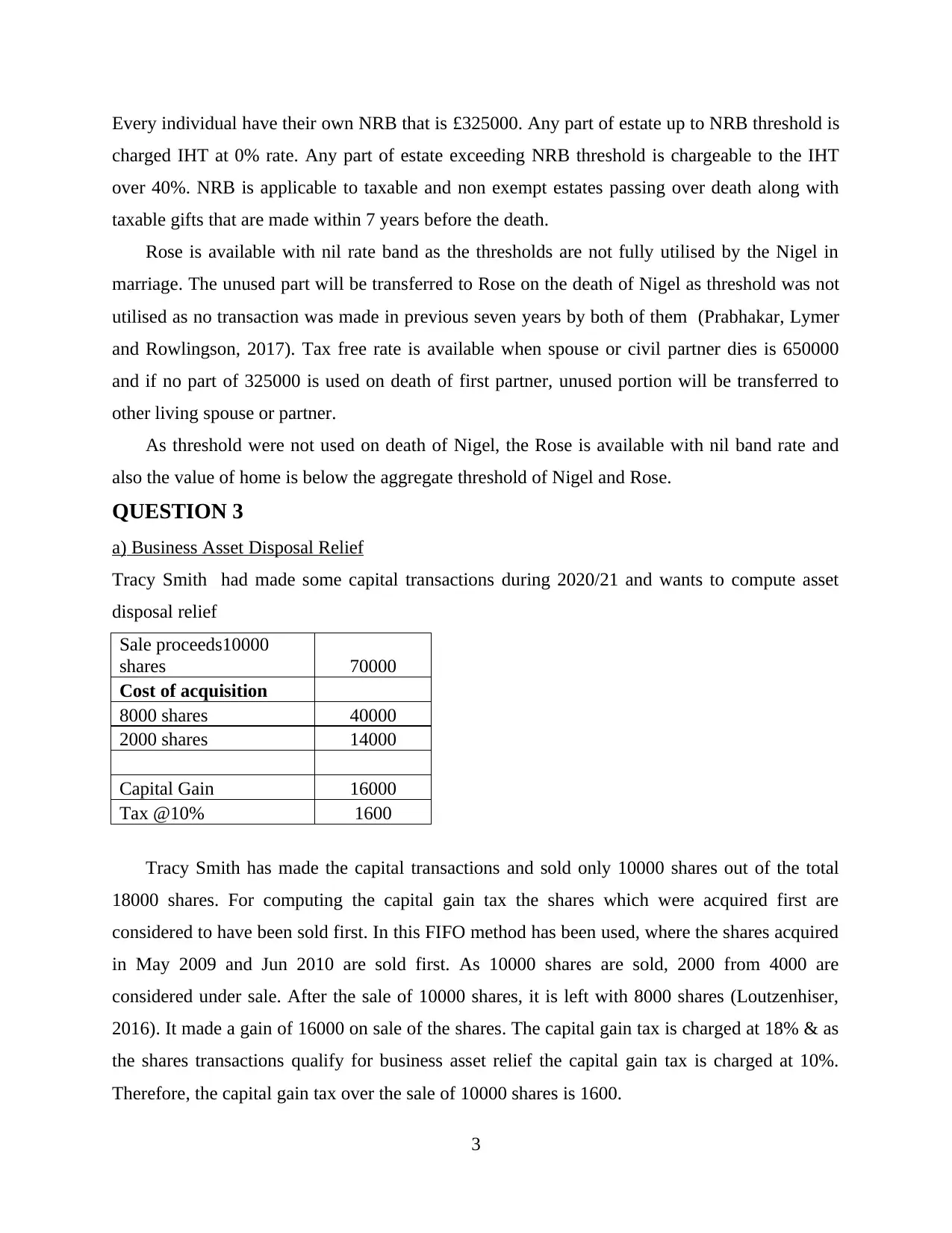
Every individual have their own NRB that is £325000. Any part of estate up to NRB threshold is
charged IHT at 0% rate. Any part of estate exceeding NRB threshold is chargeable to the IHT
over 40%. NRB is applicable to taxable and non exempt estates passing over death along with
taxable gifts that are made within 7 years before the death.
Rose is available with nil rate band as the thresholds are not fully utilised by the Nigel in
marriage. The unused part will be transferred to Rose on the death of Nigel as threshold was not
utilised as no transaction was made in previous seven years by both of them (Prabhakar, Lymer
and Rowlingson, 2017). Tax free rate is available when spouse or civil partner dies is 650000
and if no part of 325000 is used on death of first partner, unused portion will be transferred to
other living spouse or partner.
As threshold were not used on death of Nigel, the Rose is available with nil band rate and
also the value of home is below the aggregate threshold of Nigel and Rose.
QUESTION 3
a) Business Asset Disposal Relief
Tracy Smith had made some capital transactions during 2020/21 and wants to compute asset
disposal relief
Sale proceeds10000
shares 70000
Cost of acquisition
8000 shares 40000
2000 shares 14000
Capital Gain 16000
Tax @10% 1600
Tracy Smith has made the capital transactions and sold only 10000 shares out of the total
18000 shares. For computing the capital gain tax the shares which were acquired first are
considered to have been sold first. In this FIFO method has been used, where the shares acquired
in May 2009 and Jun 2010 are sold first. As 10000 shares are sold, 2000 from 4000 are
considered under sale. After the sale of 10000 shares, it is left with 8000 shares (Loutzenhiser,
2016). It made a gain of 16000 on sale of the shares. The capital gain tax is charged at 18% & as
the shares transactions qualify for business asset relief the capital gain tax is charged at 10%.
Therefore, the capital gain tax over the sale of 10000 shares is 1600.
3
charged IHT at 0% rate. Any part of estate exceeding NRB threshold is chargeable to the IHT
over 40%. NRB is applicable to taxable and non exempt estates passing over death along with
taxable gifts that are made within 7 years before the death.
Rose is available with nil rate band as the thresholds are not fully utilised by the Nigel in
marriage. The unused part will be transferred to Rose on the death of Nigel as threshold was not
utilised as no transaction was made in previous seven years by both of them (Prabhakar, Lymer
and Rowlingson, 2017). Tax free rate is available when spouse or civil partner dies is 650000
and if no part of 325000 is used on death of first partner, unused portion will be transferred to
other living spouse or partner.
As threshold were not used on death of Nigel, the Rose is available with nil band rate and
also the value of home is below the aggregate threshold of Nigel and Rose.
QUESTION 3
a) Business Asset Disposal Relief
Tracy Smith had made some capital transactions during 2020/21 and wants to compute asset
disposal relief
Sale proceeds10000
shares 70000
Cost of acquisition
8000 shares 40000
2000 shares 14000
Capital Gain 16000
Tax @10% 1600
Tracy Smith has made the capital transactions and sold only 10000 shares out of the total
18000 shares. For computing the capital gain tax the shares which were acquired first are
considered to have been sold first. In this FIFO method has been used, where the shares acquired
in May 2009 and Jun 2010 are sold first. As 10000 shares are sold, 2000 from 4000 are
considered under sale. After the sale of 10000 shares, it is left with 8000 shares (Loutzenhiser,
2016). It made a gain of 16000 on sale of the shares. The capital gain tax is charged at 18% & as
the shares transactions qualify for business asset relief the capital gain tax is charged at 10%.
Therefore, the capital gain tax over the sale of 10000 shares is 1600.
3
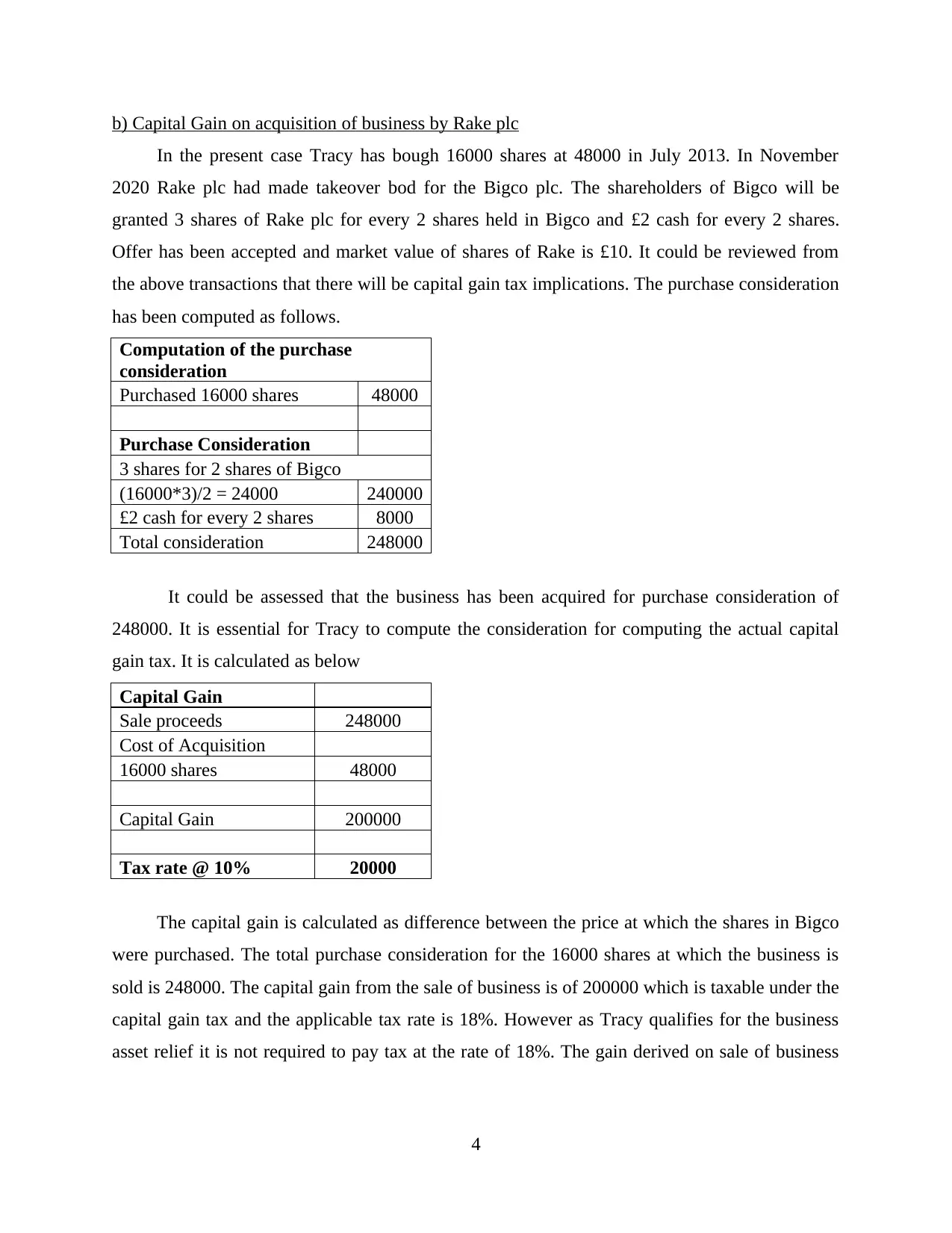
b) Capital Gain on acquisition of business by Rake plc
In the present case Tracy has bough 16000 shares at 48000 in July 2013. In November
2020 Rake plc had made takeover bod for the Bigco plc. The shareholders of Bigco will be
granted 3 shares of Rake plc for every 2 shares held in Bigco and £2 cash for every 2 shares.
Offer has been accepted and market value of shares of Rake is £10. It could be reviewed from
the above transactions that there will be capital gain tax implications. The purchase consideration
has been computed as follows.
Computation of the purchase
consideration
Purchased 16000 shares 48000
Purchase Consideration
3 shares for 2 shares of Bigco
(16000*3)/2 = 24000 240000
£2 cash for every 2 shares 8000
Total consideration 248000
It could be assessed that the business has been acquired for purchase consideration of
248000. It is essential for Tracy to compute the consideration for computing the actual capital
gain tax. It is calculated as below
Capital Gain
Sale proceeds 248000
Cost of Acquisition
16000 shares 48000
Capital Gain 200000
Tax rate @ 10% 20000
The capital gain is calculated as difference between the price at which the shares in Bigco
were purchased. The total purchase consideration for the 16000 shares at which the business is
sold is 248000. The capital gain from the sale of business is of 200000 which is taxable under the
capital gain tax and the applicable tax rate is 18%. However as Tracy qualifies for the business
asset relief it is not required to pay tax at the rate of 18%. The gain derived on sale of business
4
In the present case Tracy has bough 16000 shares at 48000 in July 2013. In November
2020 Rake plc had made takeover bod for the Bigco plc. The shareholders of Bigco will be
granted 3 shares of Rake plc for every 2 shares held in Bigco and £2 cash for every 2 shares.
Offer has been accepted and market value of shares of Rake is £10. It could be reviewed from
the above transactions that there will be capital gain tax implications. The purchase consideration
has been computed as follows.
Computation of the purchase
consideration
Purchased 16000 shares 48000
Purchase Consideration
3 shares for 2 shares of Bigco
(16000*3)/2 = 24000 240000
£2 cash for every 2 shares 8000
Total consideration 248000
It could be assessed that the business has been acquired for purchase consideration of
248000. It is essential for Tracy to compute the consideration for computing the actual capital
gain tax. It is calculated as below
Capital Gain
Sale proceeds 248000
Cost of Acquisition
16000 shares 48000
Capital Gain 200000
Tax rate @ 10% 20000
The capital gain is calculated as difference between the price at which the shares in Bigco
were purchased. The total purchase consideration for the 16000 shares at which the business is
sold is 248000. The capital gain from the sale of business is of 200000 which is taxable under the
capital gain tax and the applicable tax rate is 18%. However as Tracy qualifies for the business
asset relief it is not required to pay tax at the rate of 18%. The gain derived on sale of business
4
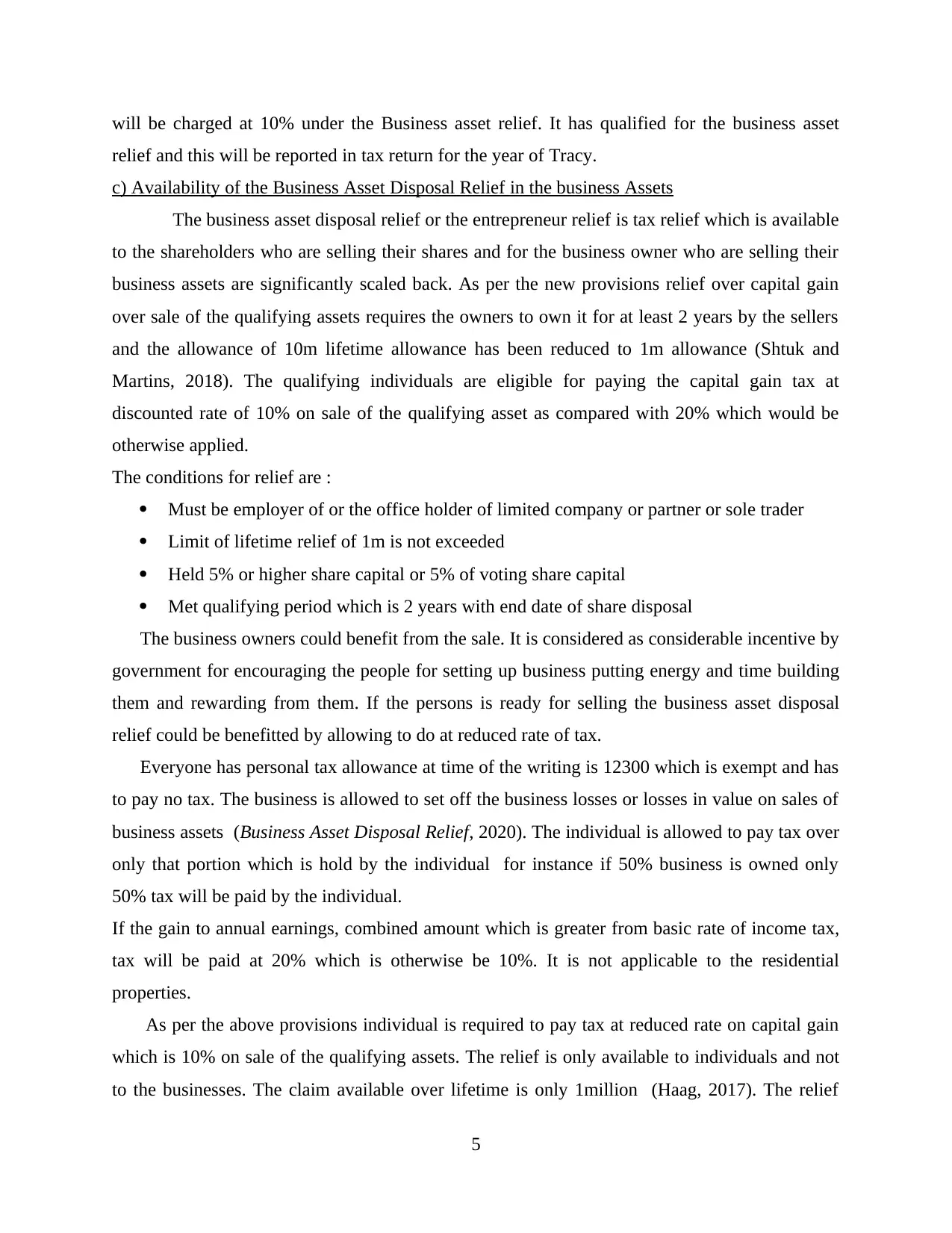
will be charged at 10% under the Business asset relief. It has qualified for the business asset
relief and this will be reported in tax return for the year of Tracy.
c) Availability of the Business Asset Disposal Relief in the business Assets
The business asset disposal relief or the entrepreneur relief is tax relief which is available
to the shareholders who are selling their shares and for the business owner who are selling their
business assets are significantly scaled back. As per the new provisions relief over capital gain
over sale of the qualifying assets requires the owners to own it for at least 2 years by the sellers
and the allowance of 10m lifetime allowance has been reduced to 1m allowance (Shtuk and
Martins, 2018). The qualifying individuals are eligible for paying the capital gain tax at
discounted rate of 10% on sale of the qualifying asset as compared with 20% which would be
otherwise applied.
The conditions for relief are :
Must be employer of or the office holder of limited company or partner or sole trader
Limit of lifetime relief of 1m is not exceeded
Held 5% or higher share capital or 5% of voting share capital
Met qualifying period which is 2 years with end date of share disposal
The business owners could benefit from the sale. It is considered as considerable incentive by
government for encouraging the people for setting up business putting energy and time building
them and rewarding from them. If the persons is ready for selling the business asset disposal
relief could be benefitted by allowing to do at reduced rate of tax.
Everyone has personal tax allowance at time of the writing is 12300 which is exempt and has
to pay no tax. The business is allowed to set off the business losses or losses in value on sales of
business assets (Business Asset Disposal Relief, 2020). The individual is allowed to pay tax over
only that portion which is hold by the individual for instance if 50% business is owned only
50% tax will be paid by the individual.
If the gain to annual earnings, combined amount which is greater from basic rate of income tax,
tax will be paid at 20% which is otherwise be 10%. It is not applicable to the residential
properties.
As per the above provisions individual is required to pay tax at reduced rate on capital gain
which is 10% on sale of the qualifying assets. The relief is only available to individuals and not
to the businesses. The claim available over lifetime is only 1million (Haag, 2017). The relief
5
relief and this will be reported in tax return for the year of Tracy.
c) Availability of the Business Asset Disposal Relief in the business Assets
The business asset disposal relief or the entrepreneur relief is tax relief which is available
to the shareholders who are selling their shares and for the business owner who are selling their
business assets are significantly scaled back. As per the new provisions relief over capital gain
over sale of the qualifying assets requires the owners to own it for at least 2 years by the sellers
and the allowance of 10m lifetime allowance has been reduced to 1m allowance (Shtuk and
Martins, 2018). The qualifying individuals are eligible for paying the capital gain tax at
discounted rate of 10% on sale of the qualifying asset as compared with 20% which would be
otherwise applied.
The conditions for relief are :
Must be employer of or the office holder of limited company or partner or sole trader
Limit of lifetime relief of 1m is not exceeded
Held 5% or higher share capital or 5% of voting share capital
Met qualifying period which is 2 years with end date of share disposal
The business owners could benefit from the sale. It is considered as considerable incentive by
government for encouraging the people for setting up business putting energy and time building
them and rewarding from them. If the persons is ready for selling the business asset disposal
relief could be benefitted by allowing to do at reduced rate of tax.
Everyone has personal tax allowance at time of the writing is 12300 which is exempt and has
to pay no tax. The business is allowed to set off the business losses or losses in value on sales of
business assets (Business Asset Disposal Relief, 2020). The individual is allowed to pay tax over
only that portion which is hold by the individual for instance if 50% business is owned only
50% tax will be paid by the individual.
If the gain to annual earnings, combined amount which is greater from basic rate of income tax,
tax will be paid at 20% which is otherwise be 10%. It is not applicable to the residential
properties.
As per the above provisions individual is required to pay tax at reduced rate on capital gain
which is 10% on sale of the qualifying assets. The relief is only available to individuals and not
to the businesses. The claim available over lifetime is only 1million (Haag, 2017). The relief
5
Paraphrase This Document
Need a fresh take? Get an instant paraphrase of this document with our AI Paraphraser

could also be claimed for more than once if the gain is within limit of 1 million. Gains exceeding
the lifetime allowance will be taxed at the rate of 20%.
6
the lifetime allowance will be taxed at the rate of 20%.
6
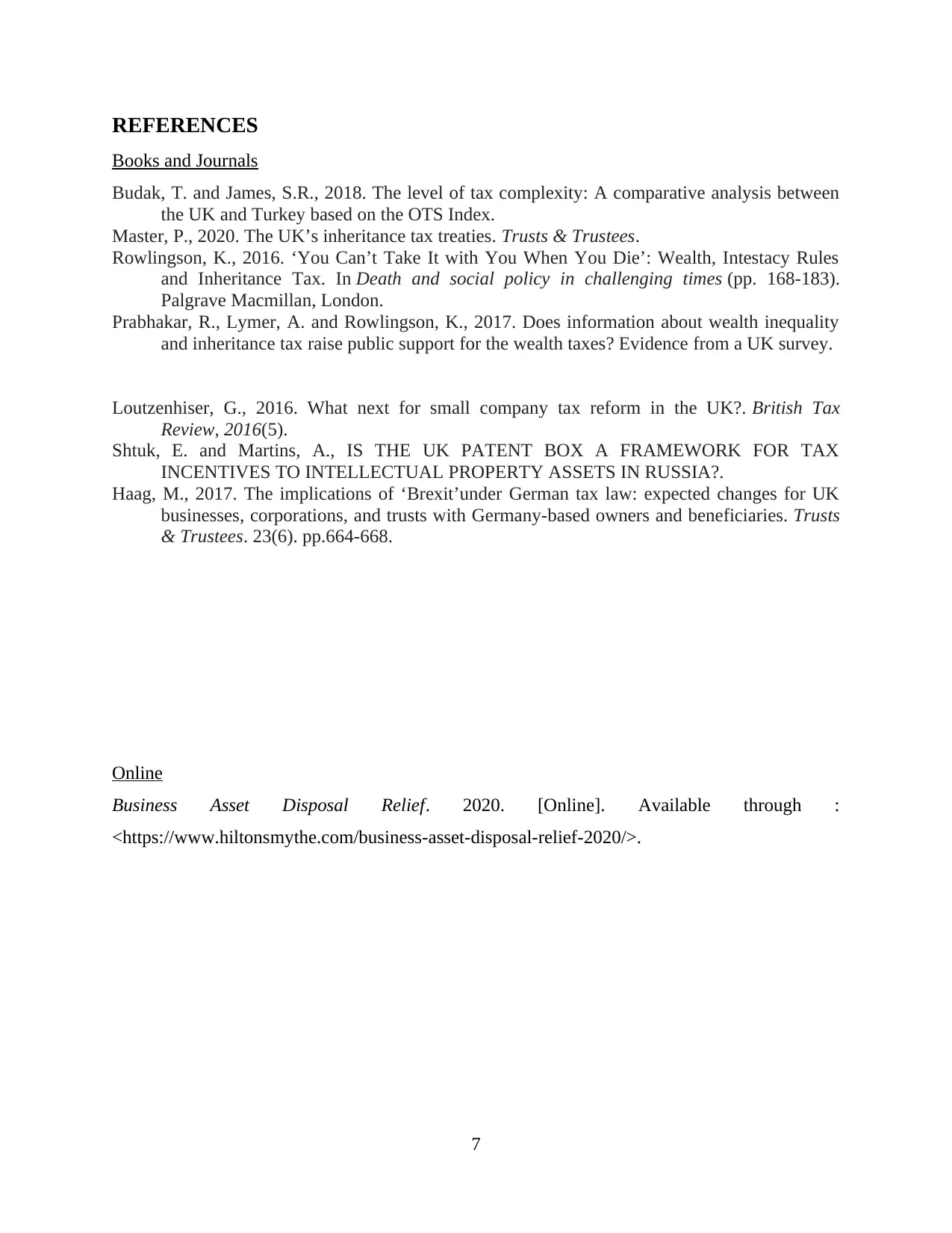
REFERENCES
Books and Journals
Budak, T. and James, S.R., 2018. The level of tax complexity: A comparative analysis between
the UK and Turkey based on the OTS Index.
Master, P., 2020. The UK’s inheritance tax treaties. Trusts & Trustees.
Rowlingson, K., 2016. ‘You Can’t Take It with You When You Die’: Wealth, Intestacy Rules
and Inheritance Tax. In Death and social policy in challenging times (pp. 168-183).
Palgrave Macmillan, London.
Prabhakar, R., Lymer, A. and Rowlingson, K., 2017. Does information about wealth inequality
and inheritance tax raise public support for the wealth taxes? Evidence from a UK survey.
Loutzenhiser, G., 2016. What next for small company tax reform in the UK?. British Tax
Review, 2016(5).
Shtuk, E. and Martins, A., IS THE UK PATENT BOX A FRAMEWORK FOR TAX
INCENTIVES TO INTELLECTUAL PROPERTY ASSETS IN RUSSIA?.
Haag, M., 2017. The implications of ‘Brexit’under German tax law: expected changes for UK
businesses, corporations, and trusts with Germany-based owners and beneficiaries. Trusts
& Trustees. 23(6). pp.664-668.
Online
Business Asset Disposal Relief. 2020. [Online]. Available through :
<https://www.hiltonsmythe.com/business-asset-disposal-relief-2020/>.
7
Books and Journals
Budak, T. and James, S.R., 2018. The level of tax complexity: A comparative analysis between
the UK and Turkey based on the OTS Index.
Master, P., 2020. The UK’s inheritance tax treaties. Trusts & Trustees.
Rowlingson, K., 2016. ‘You Can’t Take It with You When You Die’: Wealth, Intestacy Rules
and Inheritance Tax. In Death and social policy in challenging times (pp. 168-183).
Palgrave Macmillan, London.
Prabhakar, R., Lymer, A. and Rowlingson, K., 2017. Does information about wealth inequality
and inheritance tax raise public support for the wealth taxes? Evidence from a UK survey.
Loutzenhiser, G., 2016. What next for small company tax reform in the UK?. British Tax
Review, 2016(5).
Shtuk, E. and Martins, A., IS THE UK PATENT BOX A FRAMEWORK FOR TAX
INCENTIVES TO INTELLECTUAL PROPERTY ASSETS IN RUSSIA?.
Haag, M., 2017. The implications of ‘Brexit’under German tax law: expected changes for UK
businesses, corporations, and trusts with Germany-based owners and beneficiaries. Trusts
& Trustees. 23(6). pp.664-668.
Online
Business Asset Disposal Relief. 2020. [Online]. Available through :
<https://www.hiltonsmythe.com/business-asset-disposal-relief-2020/>.
7
1 out of 9
Your All-in-One AI-Powered Toolkit for Academic Success.
+13062052269
info@desklib.com
Available 24*7 on WhatsApp / Email
![[object Object]](/_next/static/media/star-bottom.7253800d.svg)
Unlock your academic potential
© 2024 | Zucol Services PVT LTD | All rights reserved.